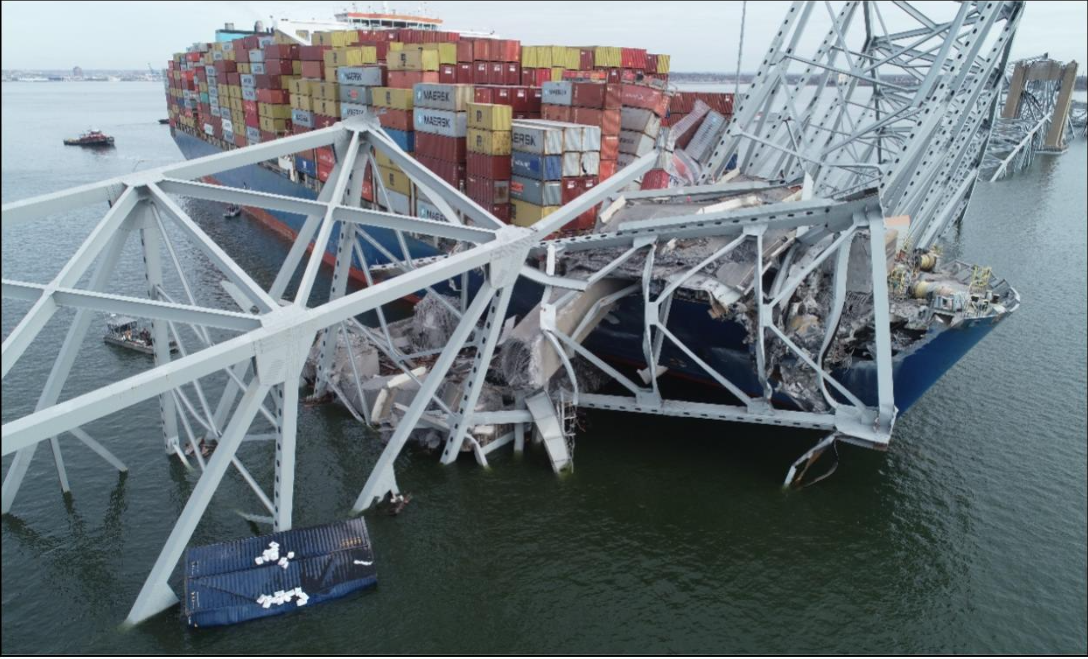The Weekly Reflektion 30/2024
Carrying out a risk assessment before getting on with the job requires identification of likely hazards and threats and how these can be mitigated to ensure the task can be carried out safely. Some hazards and threats may be considered toounlikely that the risks are not assessed. Some hazards and threats are not thought about at all. This is where experience from incidents and accidents and in particular Major Accidents needs to be used actively.
How do you consider the unthinkable in your risk assessements?

On March 26, 2024, about 0129 hrs., the 947-foot-long Singapore-flagged containership Dali was sailing out of Baltimore Harbor in Maryland. A pilot was onboard to assist in the navigation. The ship experienced loss of electrical power and propulsion and became uncontrollable. It struck the southern pier supporting the central truss spans of the Francis Scott Key Bridge (Key Bridge). A portion of the bridge subsequently collapsed into the river, and portions of the deck and the truss spans fell onto the vessel’s forward deck. A seven-person road maintenance crew and an inspector were on the bridge fixing potholes when the vessel struck it. Police units were stationed at either end of the bridge to alternate traffic on the northbound lanes to protect the construction crew. The inspector escaped unharmed, and one of the construction crewmembers survived with serious injuries. Six of the construction workers were fatally injured and their bodies were subsequently recovered. One of the 23 persons aboard the Dali was injured.
On 24th June 2024 the National Transportation Safety Board (NTSB), who are charged with investigating the incident, issued an investigative update. The NTSB emphasised that no conclusions on the causes of the incident have been made.
Three minutes before the collision, a primary electrical breaker tripped causing a blackout. The single diesel engine shutdown automatically and the ship lost propulsion and there was no power to move the rudder. At this time the ship was travelling at 9 knots and about three ship lengths from the bridge. The crew restored electrical power and the pilot onboard called for assistance from tugboats in the area and ordered the anchor dropped. A second blackout occurred, and a VHF marine radio call was made to warn waterborne traffic. The pilot’s dispatcher called the duty police officer to inform them of the situation. Two minutes before the collision the bridge was closed to all traffic. When the ship hit the southern pier, the inspector was walking along the bridge and managed to run to safety. The seven construction workers were in their vehicles and fell with them into the water. Only one managed to free himself and was rescued by a police boat at 0155 hrs.
There were some electrical problems on the Dali when it was in port at Baltimore, however how relevant these were for the subsequent problems is not yet clear. The NTSB planned areas of investigation include oceangoing vessels’ propulsion and electrical systems; the frequency and causes of vessel contacts with bridges over navigable waters; and bridge-strike mitigation measures such as a combination of vessel-size restrictions, vessel-assist tugs, and bridge-pier protection.
Stopping all traffic over a bridge each time a large vessel passes seems unrealistic. Similarly, stopping any maintenance work on the bridge. The primary risk mitigation is to ensure vessels do not lose control and threaten the bridge integrity. Loss of control is however not unthinkable and therefore contingency measures including emergency response procedures must be in place.
